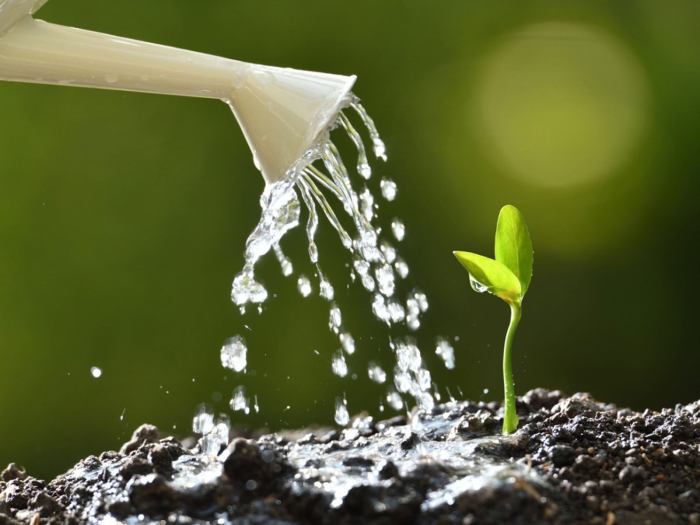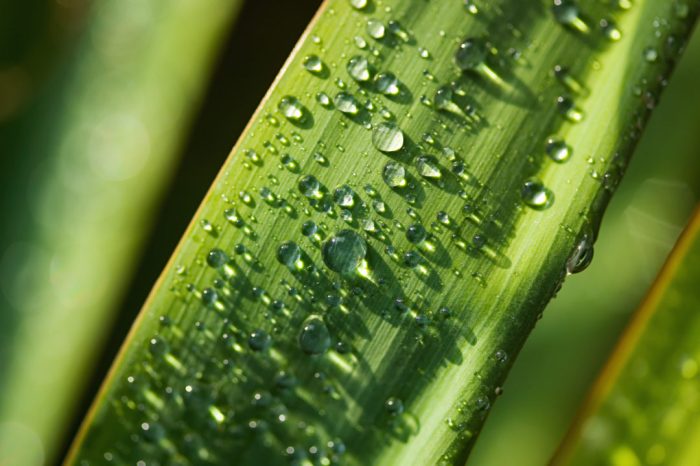Why Do Plants Love Water?
Water’s Role in Plant Physiology: Why Do Plants Love Water
Why do plants love water – Water is fundamental to all aspects of plant life, acting as both a reactant and a medium for vital processes. Understanding its role in plant physiology is key to comprehending plant growth, development, and survival.
Osmosis and Water Uptake in Plant Cells
Plants absorb water primarily through their roots via osmosis. Osmosis is the movement of water across a semi-permeable membrane from a region of high water potential (low solute concentration) to a region of low water potential (high solute concentration). The cell walls and membranes of root cells act as these semi-permeable membranes. Water moves into the root cells, creating a higher water potential inside the cells than in the surrounding soil.
This difference in water potential drives the continuous uptake of water from the soil into the plant.
Water Transport Throughout the Plant
Water travels from the roots to the leaves through a system of vascular tissues: xylem and phloem. Xylem vessels, composed of dead cells, form a continuous pipeline transporting water and minerals upwards from the roots, driven by transpiration pull (evaporation of water from leaves) and root pressure. Phloem transports sugars and other organic compounds produced during photosynthesis throughout the plant.
Water’s Role in Photosynthesis
Water is a crucial reactant in photosynthesis, the process by which plants convert light energy into chemical energy. During the light-dependent reactions, water molecules are split (photolysis) to release electrons, which are then used to power the electron transport chain. Oxygen is a byproduct of this process.
Turgor Pressure and Plant Structure
Turgor pressure, the pressure exerted by water within a plant cell against its cell wall, is essential for maintaining plant structure and growth. This pressure keeps cells firm and upright, providing support for leaves, stems, and flowers. Loss of turgor pressure (wilting) occurs when plants lose water.
Water Requirements of Different Plant Species
Plants exhibit diverse adaptations to their water environments. Succulents, adapted to arid conditions, have thick, fleshy leaves and stems that store water, reducing their water loss. Aquatic plants, on the other hand, are submerged or partially submerged in water and have specialized structures to facilitate efficient water uptake and gas exchange.
Effects of Water Deficiency and Excess on Plant Growth
Both water deficiency and excess negatively impact plant growth. The following table summarizes the effects on different plant parts and the underlying cellular mechanisms:
| Plant Part | Water Deficiency Effect | Water Excess Effect | Cellular Mechanism Involved |
|---|---|---|---|
| Roots | Reduced growth, impaired water uptake | Reduced oxygen availability, root rot | Osmotic imbalance, anaerobic respiration |
| Leaves | Wilting, leaf senescence, reduced photosynthesis | Chlorosis, leaf damage | Reduced turgor pressure, impaired chloroplast function |
| Stems | Reduced growth, weakening | Reduced structural integrity | Reduced cell expansion, cell wall weakening |
| Flowers/Fruits | Reduced flower production, smaller fruit size | Reduced fruit quality | Impaired reproductive processes, nutrient imbalance |
Water and Plant Metabolism
Water is involved in numerous biochemical processes essential for plant metabolism. Its role extends beyond a simple solvent; it directly participates in various enzymatic reactions and influences the overall efficiency of metabolic pathways.
Biochemical Processes Requiring Water
Water acts as a reactant in many metabolic reactions, including photosynthesis, hydrolysis reactions (breaking down complex molecules), and the transport of nutrients and metabolites within the plant. It also plays a crucial role in maintaining the proper hydration of enzymes and other proteins, ensuring their optimal function.
Plants thrive on water because it’s essential for their survival; it’s the lifeblood of their processes. To understand why, consider what a plant actually does with water; for a detailed explanation, check out this helpful resource: what dose a plant the use water for. Essentially, water facilitates photosynthesis, nutrient transport, and overall plant growth, making it clear why plants are so dependent on a consistent water supply.
Water’s Role in Regulating Plant Temperature
Transpiration, the loss of water vapor from plant leaves, plays a significant role in regulating plant temperature. As water evaporates from the leaf surfaces, it carries away heat, preventing overheating, especially in hot and sunny conditions. This cooling effect is crucial for maintaining optimal enzyme activity and preventing damage to plant tissues.
Essential Nutrients Absorbed Through Water
Plants absorb essential nutrients, such as nitrogen, phosphorus, potassium, and micronutrients, through their roots, dissolved in water. These nutrients are vital for various metabolic processes, including enzyme synthesis, chlorophyll production, and energy metabolism. Water acts as the vehicle delivering these essential elements to the plant’s cells.
Water Availability and Enzyme Activity
Water availability directly influences enzyme activity. Enzymes require a specific hydration level for optimal function. Water stress can lead to enzyme denaturation or reduced catalytic activity, impacting numerous metabolic processes. Conversely, excessive water can also disrupt enzyme function by altering the cellular environment.
Plant Adaptations to Drought Conditions
Plants have evolved various mechanisms to cope with drought conditions. Some plants develop extensive root systems to access deeper water sources. Others exhibit drought tolerance through mechanisms such as leaf rolling (reducing surface area for transpiration) or the production of abscisic acid (ABA), a hormone that helps regulate water loss.
Key Metabolic Pathways Affected by Water Availability
- Photosynthesis
- Respiration
- Protein synthesis
- Nutrient uptake
- Hormone production
- Enzyme activity
Water and Plant Growth
Water availability is a major determinant of plant growth and development, impacting every stage from seed germination to mature plant yield. Understanding this relationship is crucial for optimizing agricultural practices and managing plant health.
Water Availability and Seed Germination
Water is essential for seed germination. It imbibes the seed, activating enzymes and initiating metabolic processes necessary for embryo growth. Sufficient water ensures proper cell expansion and the emergence of the radicle (embryonic root) and plumule (embryonic shoot).
Water Stress and Plant Growth Rates
Water stress significantly reduces plant growth rates. Limited water availability restricts cell expansion, limits photosynthesis, and reduces nutrient uptake. Severe water stress can lead to stunted growth, reduced yield, and even plant death. For example, a corn plant experiencing prolonged drought will exhibit significantly reduced stalk height and ear size compared to a well-watered plant.
Experiment: Effect of Varying Water Amounts on Plant Growth
This experiment will test the effect of varying watering amounts on the growth of
-Lactuca sativa* (lettuce).
Methodology: Three groups of lettuce seedlings will be grown under identical conditions (light, temperature, soil type) but with different watering regimes: Group 1 (control): regular watering; Group 2: 50% reduced watering; Group 3: 75% reduced watering. Plant height and leaf number will be measured weekly for 4 weeks.
Expected Results: Group 1 will show the greatest growth, followed by Group 2, and then Group 3. Group 3 might exhibit severe wilting and stunted growth.
Controls: Identical environmental conditions (light, temperature, soil type) for all groups, consistent fertilization, and use of genetically similar seedlings.
Visible Signs of Water Stress
Visible signs of water stress include wilting (loss of turgor pressure), leaf rolling, leaf scorch (brown edges), reduced leaf size, and stunted growth. Severe water stress can lead to leaf abscission (dropping of leaves) and eventually plant death.
Comparison of Plant Growth Under Different Water Conditions
A well-watered lettuce plant will be taller, have larger, greener leaves, and a more robust overall structure compared to a drought-stressed plant, which will be stunted, have smaller, yellowing leaves, and appear withered.
Stages of Plant Growth Under Different Water Conditions

Source: gardeningknowhow.com
Well-watered: Seed germination → rapid seedling growth → vigorous vegetative growth → abundant flowering and fruiting → mature plant. Drought-stressed: Seed germination (potentially delayed) → slow seedling growth → stunted vegetative growth → reduced or absent flowering and fruiting → premature senescence and death (potentially).
Environmental Factors Affecting Water Uptake
Several environmental factors influence a plant’s ability to absorb and retain water. Understanding these factors is critical for predicting plant growth and distribution in various ecosystems.
Influence of Soil Type and Structure
Soil type and structure significantly affect water availability to plants. Sandy soils drain quickly, offering less water retention, while clay soils retain water but can become waterlogged, reducing oxygen availability to roots. Loamy soils, with a mixture of sand, silt, and clay, offer a balance of water retention and drainage.
Environmental Factors Influencing Transpiration
Temperature, humidity, and wind all influence transpiration rates. High temperatures and low humidity increase transpiration, while wind accelerates water loss from leaves. These factors interact to determine the overall water demand on the plant.
Plant Adaptations for Efficient Water Acquisition
Plants have evolved various adaptations to improve water acquisition. Stomata, tiny pores on leaf surfaces, regulate gas exchange and water loss. Extensive root systems allow plants to access water from larger soil volumes. Some plants have specialized root structures, such as contractile roots that pull the plant deeper into the soil.
Pollution and Plant Water Uptake, Why do plants love water

Source: inharmony.com
Pollution can negatively impact plant water uptake and overall health. Heavy metals and other pollutants can accumulate in the soil, affecting root function and reducing water absorption. Air pollutants can damage leaves, increasing water loss through transpiration.
Water Availability and Plant Distribution
Water availability is a major determinant of plant species distribution. Different plant species have evolved different tolerances to water stress. Desert plants are adapted to arid conditions, while aquatic plants thrive in waterlogged environments. This leads to distinct plant communities in various ecosystems.
Pathway of Water from Soil to Plant Atmosphere
The pathway can be described as follows: Soil water → root hairs → cortex cells → endodermis → xylem vessels → stem → leaves → mesophyll cells → stomata → atmosphere.
Questions and Answers
What happens to a plant if it receives too little water?
Water deficiency leads to wilting, stunted growth, leaf discoloration, and ultimately, death. The plant’s cells lose turgor pressure, affecting its structural integrity and metabolic processes.
Can plants get too much water?
Yes, overwatering can lead to root rot, hindering nutrient uptake and causing the plant to suffocate. Excess water deprives roots of oxygen, crucial for respiration.
How do plants transport water from their roots to their leaves?
Water is transported through a combination of osmosis and capillary action within the xylem vessels, a specialized vascular tissue.
Why are some plants more drought-tolerant than others?
Drought tolerance is due to various adaptations, including specialized root systems, efficient water storage mechanisms (like succulents), and modified leaf structures to reduce water loss through transpiration.




















